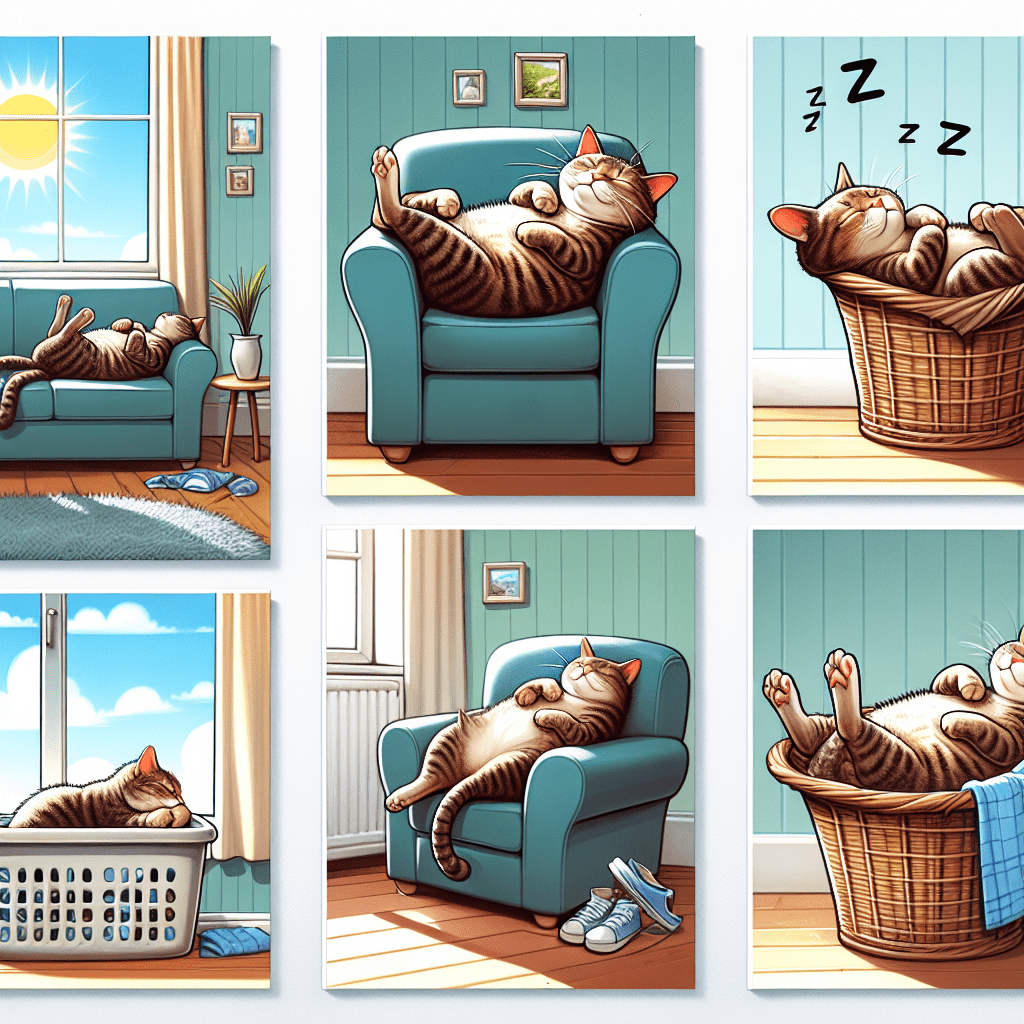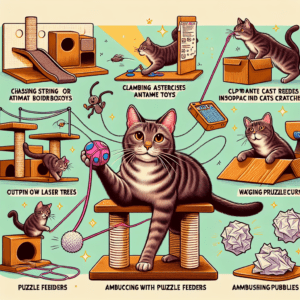Get your free Book Here

Is Your Cat a Professional Napper? Understanding Feline Sleep Habits
Cats have earned a reputation as expert nappers, spending up to two-thirds of their lives in dreamland. For many cat owners, their feline friends can seem like they have perfected the art of relaxation. But what drives this seemingly endless slumber? Join me on a journey to uncover the secrets of your cat’s sleeping habits, and learn how to appreciate and embrace their unique lifestyle as a professional napper.
Chapter 1: The Science Behind Cat Sleep
Understanding your cat’s sleep starts with science. Cats are known for their polyphasic sleep patterns, meaning they experience multiple short sleep cycles throughout the day and night rather than a single extended period of slumber. On average, this adds up to about 12-16 hours of sleep per day, with kittens and older cats sleeping even more.
But why do cats need so much rest? The answer lies in their evolution. Cats are predators, and their bodies have evolved to conserve energy for hunting. In the wild, a cat must conserve as much energy as possible for short bursts of activity, whether that’s stalking prey or defending territory. Therefore, your seemingly sedentary kitty is biologically wired to be a champion of relaxation.
Chapter 2: Sleep Stages and Patterns
Just like humans, cats experience different stages of sleep, transitioning between light and deep sleep. Their sleep is characterized by both Non-Rapid Eye Movement (NREM) and Rapid Eye Movement (REM) sleep. During NREM, cats may enter a deep restorative sleep where muscle repair and growth occur, while REM sleep is when they experience dreams.
Interestingly, cats can remain alert even when they’re asleep. They have a unique ability to enter a state of “catnap vigilance,” allowing them to quickly respond to threats or opportunities in their environment. This means your cat might appear to be in a deep sleep, but it’s always partially aware of its surroundings, making those long stretches of napping a clever strategy for survival.
Chapter 3: The Importance of Cat Napping
Some purists argue that napping is essential for your whiskered buddy’s health and well-being. Just like humans, sleep is crucial for a cat’s cognitive function, healing, and overall health. Insufficient sleep can lead to an array of issues, from behavioral problems to obesity.
Cats, particularly indoor ones, can develop energy imbalances from a lack of stimulation. Therefore, regular napping can help them reset and prepare for their periods of play. It’s a reminder that while your kitty may seem lazy, they’re actually working hard to keep their energy in check!
Chapter 4: Home Environment and Sleep Quality
Just as we humans create cozy sleep environments, cats also thrive in spaces that provide comfort and security. The ideal sleep environment for a cat includes warm, soft bedding, familiar scents, and a safe, quiet area to retreat to.
Creating a space in your home that optimizes your cat’s napping habits doesn’t require a complete renovation. Simply provide a cozy bed or blanket in a sunny spot, or invest in a cat tree that allows them to perch and snooze at a higher vantage point. Remember, a happy cat makes for a happy home!
Chapter 5: Age and Sleep Changes
Much like us, a cat’s sleep patterns change with age. Kittens sleep for up to 20 hours a day as they grow and develop. As they transition into adulthood, their sleeping habits stabilize but can vary significantly depending on their level of activity and environmental stressors.
Seniors, on the other hand, may exhibit more erratic sleeping patterns. They could sleep even more due to health issues or decreased mobility. If you notice significant changes in your cat’s sleeping behavior, it’s essential to consult a veterinarian to rule out potential health problems.
Chapter 6: Common Myths About Cat Sleep
There’s much misinformation surrounding cat sleep. One prevalent myth is that cats sleep because they are lazy and lack activity. In reality, their sleep patterns are very much tied to their instinctual needs and natural behaviors.
Another common misconception is that nocturnal cats should be awake while their owners are. In truth, cats are crepuscular, which means they’re most active during dawn and dusk. This ties back to their hunting instincts, where their prey (like rodents) is also active during these times. Being aware of this natural behavior can help you adjust playtime routines, making it easier for both you and your cat.
Chapter 7: How to Encourage Healthy Sleeping Patterns
If you think your cat might benefit from a more structured sleep routine, several strategies can encourage healthy sleeping patterns.
- Routine: Keep feeding times and playtimes consistent to help regulate your cat’s internal clock.
- Play: Engage in short, energetic play sessions throughout the day to promote activity that can lead to quality sleep.
- Calm Environment: Create a serene home environment. Minimize loud noises and disturbances during your cat’s sleep time, and ensure they have a cozy and safe space to retreat.
- Health Check: Regular vet visits will help address any health issues that may be affecting your cat’s sleep quality.
These initiatives can help create opportunities for your feline friend to embrace their role as a professional napper fully!
Chapter 8: Understanding Your Cat’s Sleep Signals
Lastly, it’s essential to recognize and respect your cat’s sleep signals. Some may exhibit behaviors that indicate they are ready for sleep, such as yawning, settling into a curled position, and kneading their paws.
Monitor these signs to help you establish an understanding of your cat’s needs; in a world that’s often busy and chaotic, being in-tune with your pet’s rhythms can strengthen your bond. Plus, learning to appreciate their elegant napping habits can encourage you to take a cue from your feline friend—after all, we humans could likely stand to embrace a few more naps ourselves.
Conclusion
Understanding your cat’s obsession with napping is more than indulging their cuteness—it’s about recognizing the instinctual, biological, and emotional needs that underpin their behaviors. Sleep is essential to their well-being and is an intrinsic part of their daily existence.
So next time you catch your kitty in a deep snooze, remember: your cat is not just napping but embracing a profession perfected through thousands of years of evolution. Understand, respect, and celebrate your cat’s sleeping habits, and they’ll continue to thrive as the adored professional nappers that they are.
FAQs
Q: Why do cats sleep so much?
A: Cats sleep extensively to conserve energy for hunting, which is driven by their predatory instinct.
Q: Is it normal for my cat to sleep more than 16 hours a day?
A: Yes, it’s normal, especially for kittens and elderly cats. If there’s a sudden change or other health concerns, consult a veterinarian.
Q: Can I train my cat to sleep less?
A: It’s not necessarily about training your cat to sleep less but ensuring they receive adequate stimulation through play and a structured routine.
Q: Should I wake my cat if they’re sleeping?
A: Generally, let your cat sleep. However, if you notice unusual patterns or changes, it’s worth investigating further.
Q: How can I tell if my cat is sleeping well?
A: Signs of good sleep include regular sleep patterns, comfort while sleeping, and an active, playful demeanor when awake.
Q: Are certain breeds more prone to being lazy?
A: While personality varies by individual, some breeds, like Persians and Ragdolls, tend to enjoy lounging more than others.
Q: Is there an ideal sleep environment for my cat?
A: Yes, a cozy, warm, quiet space where they feel safe will help promote quality sleep.
Q: Can stress affect my cat’s sleep?
A: Absolutely. Stressful environments can affect your cat’s ability to relax and rest well.
Q: Is there a connection between my cat’s sleeping habits and their health?
A: Yes, excessive sleeping or changes in sleeping patterns can signal underlying health issues, so always monitor for changes and consult a veterinarian if necessary.
Q: Can I create a routine that encourages better sleep habits for my cat?
A: Yes, establishing feeding and playtime routines can help regulate your cat’s internal clock and promote healthier sleep patterns.
Instantly Access Your Free Children’s Books Here! (https://payhip.com/BlueCherryStore) – Disclaimer: As an Amazon Associate, I earn from qualifying purchases, I may earn a commission from qualifying purchases as an affiliate. Please note that I only recommend products I believe will provide value to my readers.(M)







